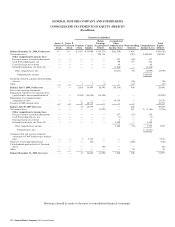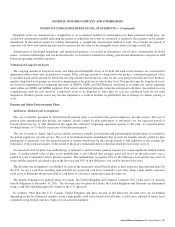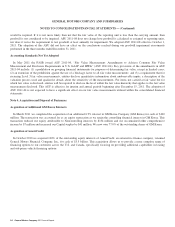General Motors 2011 Annual Report Download - page 89
Download and view the complete annual report
Please find page 89 of the 2011 General Motors annual report below. You can navigate through the pages in the report by either clicking on the pages listed below, or by using the keyword search tool below to find specific information within the annual report.GENERAL MOTORS COMPANY AND SUBSIDIARIES
NOTES TO CONSOLIDATED FINANCIAL STATEMENTS — (Continued)
Intangible assets are amortized on a straight-line or an accelerated method of amortization over their estimated useful lives. An
accelerated amortization method reflecting the pattern in which the asset will be consumed is utilized if that pattern can be reliably
determined. If that pattern cannot be reliably determined, a straight-line amortization method is used. We consider the period of
expected cash flows and underlying data used to measure the fair value of the intangible assets when selecting a useful life.
Amortization of developed technology and intellectual property is recorded in Automotive cost of sales. Amortization of brand
names, customer relationships and our dealer networks is recorded in Automotive selling, general and administrative expense or GM
Financial operating and other expenses.
Valuation of Long-Lived Assets
The carrying amount of long-lived assets and finite-lived intangible assets to be held and used in the business are evaluated for
impairment when events and circumstances warrant. If the carrying amount of a long-lived asset group is considered impaired, a loss
is recorded based on the amount by which the carrying amount exceeds the fair value for the asset group to be held and used. Product-
specific long-lived asset groups are tested for impairment at the platform or vehicle line level. Non-product specific long-lived assets
are tested for impairment on a reporting unit basis in GMNA, GME, and GM Financial and tested at or within our various reporting
units within our GMIO and GMSA segments. Fair value is determined primarily using the anticipated cash flows discounted at a rate
commensurate with the risk involved. Long-lived assets to be disposed of other than by sale are considered held for use until
disposition. Product-specific assets may become impaired as a result of declines in profitability due to changes in volume, pricing or
costs.
Pension and Other Postretirement Plans
Attribution, Methods and Assumptions
The cost of benefits provided by defined benefit pension plans is recorded in the period employees provide service. The cost of
pension plan amendments that provide for benefits already earned by plan participants is amortized over the expected period of
benefit which may be: (1) the duration of the applicable collective bargaining agreement specific to the plan; (2) expected future
working lifetime; or (3) the life expectancy of the plan participants.
The cost of medical, dental, legal service and life insurance benefits provided through postretirement benefit plans is recorded in
the period employees provide service. The cost of postretirement plan amendments that provide for benefits already earned by plan
participants is amortized over the expected period of benefit which may be the average period to full eligibility or the average life
expectancy of the plan participants, or the period to the plan’s termination date for the plan which provides legal services.
An expected return on plan asset methodology is utilized to calculate future pension expense for certain significant funded benefit
plans. A market-related value of plan assets methodology is also utilized that averages gains and losses on the plan assets over a
period of years to determine future pension expense. The methodology recognizes 60% of the difference between the fair value of
assets and the expected calculated value in the first year and 10% of that difference over each of the next four years.
The discount rate assumption is established for each of the retirement-related benefit plans at their respective measurement dates. In
the U.S. we use a cash flow matching approach that uses projected cash flows matched to spot rates along a high quality corporate
yield curve to determine the present value of cash flows to calculate a single equivalent discount rate.
The benefit obligation for pension plans in Canada, the United Kingdom and Germany comprise 92% of the non-U.S. pension
benefit obligation at December 31, 2011. The discount rates for plans in Canada, the United Kingdom and Germany are determined
using a cash flow matching approach, similar to the U.S. approach.
In countries other than the U.S., Canada, United Kingdom and those located in the Eurozone discount rates are established
depending on the local financial markets, using a high quality yield curve based on local bonds, a yield curve adjusted to reflect local
conditions using foreign currency swaps or local actuarial standards.
General Motors Company 2011 Annual Report 87
























